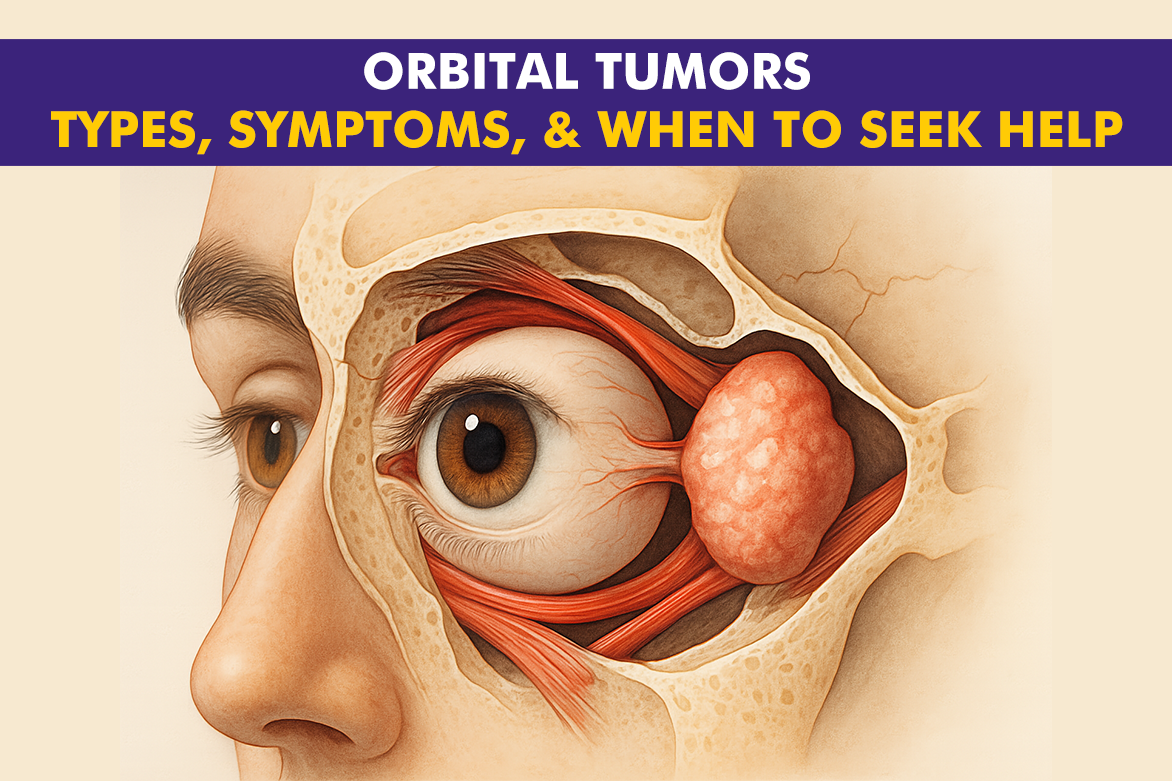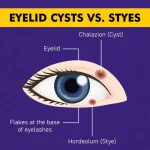Table of Contents
- Understanding the Orbit and Its Importance
- What Are Orbital Tumors?
- What Causes Orbital Tumours?
- Types of Orbital Tumors
- Recognizing Orbital Tumor Symptoms: What to Watch For
- How Are Orbital Tumors Diagnosed?
- Orbital Tumor Treatment Options: A Multidisciplinary Approach
- What to Expect After Orbital Tumor Treatment
- Preventive Measures for Orbital Tumours
- Case Study
- Final Thoughts
The eyes are our windows to the world. But what happens when a hidden abnormality in the orbit—the protective socket holding your eye—threatens sight, comfort, and quality of life? Orbital tumors, though rare, are critical to detect early and manage effectively. In this comprehensive blog, we’ll guide you through what orbital tumors are, why they occur, how to recognize their symptoms, and the advanced solutions available today at Centre For Sight – India’s leading eye care hospital network.
Understanding the Orbit and Its Importance
The orbit is a complex anatomical structure: a bony cavity that not only houses the eyeball but also contains nerves, blood vessels, muscles, and connective tissue supporting vision and eye movement. Any growth in this compact space—benign or malignant—can exert pressure or interfere with normal eye function, making timely diagnosis and intervention essential.
Did You Know?
The orbit contains over seven major bones and houses vital structures for both eyesight and facial movement. Even a small space-occupying lesion can result in significant disturbances due to how closely packed these structures are.
What Are Orbital Tumors?
Orbital tumors are abnormal tissue growths occurring within the orbit. These may be:
- Benign (non-cancerous): Typically grow slowly and do not infect nearby tissues.
- Malignant (cancerous): Can grow rapidly, infect other structures, and sometimes spread (metastasize) to distant parts of the body.
Orbital tumors can arise from:
- Structures within the orbit: Muscles, nerves, fat, lymphatic or vascular tissue.
- Adjacent regions: Sinuses, brain, or eyelid structures extending into the orbit.
- Metastatic sources: Cancers from elsewhere in the body that spread to the orbit.
What Causes Orbital Tumours?
Understanding why orbital mass eye occur can be complex, as many appear without a clear cause. However, certain factors may increase risk:
| Risk Factor | Explanation |
| Age | Some tumors are more common in children (e.g., hemangiomas), others in older adults |
| Genetics | Family history or genetic syndromes may predispose individuals |
| Previous Cancer | Metastatic spread of systemic cancers |
| Chronic Inflammation | Ongoing orbital or sinus inflammatory diseases |
| Immune System Disorders | Increased risk for lymphomas |
Types of Orbital Tumors
A variety of tumors can develop in the orbital space. Below is a table highlighting the most important ones:
| Tumor Type | Typical Age Group | Behavior | Common Symptoms |
| Hemangioma | Children | Benign | Eye bulging, swelling |
| Lymphoma | Adults/Elderly | Malignant | Bulging, double vision, discomfort |
| Meningioma | Adults | Usually Benign | Slow vision changes, chronic bulging |
| Dermoid Cyst | Children/Young Adults | Benign | Lump, mild discomfort |
| Schwannoma | Adults | Benign | Nerve weakness, asymmetry |
| Metastatic Tumors | Variable | Malignant | Variable—often rapidly progressive |
Fact Check:
While some tumors are aggressive, many childhood orbital tumors are treatable and not life-threatening. Increased vigilance is needed in adults, as the likelihood of malignancy is higher.
Recognizing Orbital Tumor Symptoms: What to Watch For
Early-stage orbital tumor symptoms may be subtle, but as the tumor grows, the following symptoms often appear:
- Proptosis (Eye Bulging): Most common sign, often painless at first.
- Double Vision (Diplopia): Tumor pressure can displace the eye or its muscles.
- Visual Changes: Blurring, shadows, or sudden loss of vision.
- Pain or Pressure: Discomfort around or behind the eye.
- Restricted Eye Movement: Difficulty moving the eye or persistent squint.
- Swelling or Redness: Particularly if accompanied by tenderness or infection symptoms.
- Noticeable Mass or Lump: Palpable under the eyebrow, eyelid, or within the orbit.
If you notice any such orbital tumor symptoms, immediate medical attention is crucial. Visit your nearest Centre For Sight for expert eye tumor treatment.
How Are Orbital Tumors Diagnosed?
Orbital tumor diagnosis is a multi-step process, requiring modern technology and expert clinical evaluation:
- Detailed Medical History and Exam
Assess duration, progression of symptoms, and any history of cancer or immune disorders. Visual acuity, color vision, eye movement, and structural changes are thoroughly evaluated
- Imaging Investigations
- CT Scan: It shows detailed cross-sections of bone and tissue. It is used in diagnosing bony invasion, tumor extent
- MRI: It shows superior soft tissue contrast; nerves, muscles, vessels. It is used in diagnosing the precise location, tumor relation.
- Ultrasound: It gives a quick, non-invasive first look. It is used in cystic vs solid nature.
- Biopsy
- Needle or surgical biopsy is sometimes essential for a definitive diagnosis, especially for lymphomas or rapidly growing masses.
- Histopathology guides both treatment and prognosis.
- Additional Tests
Blood tests, genetic analysis, or PET scans may be needed for certain conditions.
Watch here to get an in-depth explanation of orbital tumor from India’s most renowned eye surgeon – Dr. Santosh G Honavar
ORBITAL TUMORS – CLINICAL SPECTRUM AND DIAGNOSIS by Dr Santosh G Honavar, , Wed, April 26, 8:00 PM,
Orbital Tumor Treatment Options: A Multidisciplinary Approach
The orbital tumour treatment plan depends on the tumor’s type, size, location, and whether it is benign or malignant.
- Observation: For small, slow-growing, non-threatening tumors.
- Surgical Removal: Especially for benign, accessible masses—modern microsurgical techniques prioritize both tumor clearance and vision preservation.
- Radiation Therapy: Effective for lymphomas and certain malignant tumors; non-invasive with targeted technology.
- Chemotherapy: Reserved for malignant, aggressive, or metastatic tumors (e.g., advanced lymphoma or systemic cancers).
- Targeted/Immunotherapy: Emerging options for certain tumor types under eye specialist supervision.
Orbital Tumor Treatment Comparison
| Treatment | Benefits | Risks/Downsides |
| Observation | No intervention, minimal risk | May need regular follow-up |
| Surgery | Single intervention, potential cure | Risk of nerve/vision loss |
| Radiation | Non-surgical, often effective in lymphoma | Risk of dry eye, rare tissue injury |
| Chemotherapy | Systemic control | General side-effects |
| Immunotherapy | Targeted, less toxic | Still under study for many types |
What to Expect After Orbital Tumor Treatment
After Surgery:
- Mild swelling, bruising, or discomfort is common
- Vision may fluctuate before stabilizing
- Recovery can range from a few days (minor cyst removal) to several weeks (major mass)
Radiation/Chemotherapy:
- Orbital tumor treatments may be outpatient or require short hospital stays
- Supportive care (hydration, nutrition, rest) boosts recovery
- Routine follow-up imaging is critical
Managing Side Effects:
- Temporary vision changes, dryness, or swelling can occur
- Strict adherence to medications and follow-up schedules is vital
Preventive Measures for Orbital Tumours
While many orbital tumors arise spontaneously, some risks can be reduced:
- Early and regular eye check-ups, especially with a history of cancer or persistent symptoms
- Immediate attention for any unexplained eye bulge, movement limitation, vision changes, or pain
- Family awareness—genetic conditions may merit screening or early intervention
Prognosis
- Benign tumors: Excellent outcome in most with complete removal
- Malignant tumors: Success depends on size, location, and speed of intervention, but modern therapies offer hope and longevity
- Children: Generally have favorable outcomes, especially with early, specialized care
Case Study
A 45-year-old woman developed painless eye bulging over several months. She dismissed it as fatigue until friends noticed the difference in her eye position. An ophthalmologist found vision changes and ordered imaging, revealing a benign orbital hemangioma. Surgical removal restored both appearance and vision.
Key Takeaway: Never ignore persistent bulging or vision changes. Early intervention can be sight-saving.
Final Thoughts
Orbital tumors represent a serious but manageable set of conditions when addressed with urgency and expertise. Whether you are a patient noticing subtle changes or a family member encouraging a loved one to seek help, remember:
- Don’t delay medical evaluation for any persistent eye bulging, discomfort, or vision change.
- Seek a specialist in orbital disease—early and expert care makes the greatest orbital tumor treatment.
- Recovery is possible, and most patients can return to normal life with preserved or improved sight.
Your vision, your confidence, your life—are in safe hands with our dedicated eye care professionals. If you have any concerns, schedule an appointment at a trusted eye health center as soon as possible.






